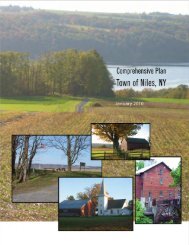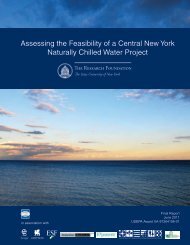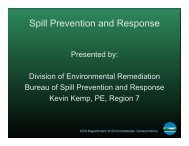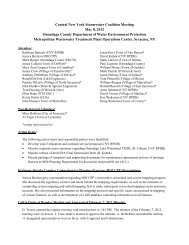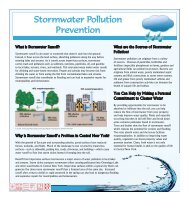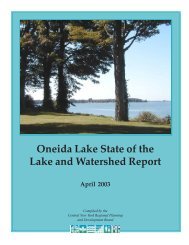A Management Strategy for Oneida Lake and its ... - CNY RPDB Home
A Management Strategy for Oneida Lake and its ... - CNY RPDB Home
A Management Strategy for Oneida Lake and its ... - CNY RPDB Home
Create successful ePaper yourself
Turn your PDF publications into a flip-book with our unique Google optimized e-Paper software.
Recommendation<br />
Explore the feasibility of extending the time period during<br />
which the New York State Canal Corporation is responsible<br />
<strong>for</strong> water level controls, as long as the extension does<br />
not impact current navigation law. Water level management<br />
might begin when the lake is declared ice-free by the<br />
<strong>Oneida</strong> Fish Cultural Station, or by March 20 in years<br />
when the ice is out early or there is no ice. Water level<br />
management might end when the lake is designated as ice<br />
covered by Cornell University, or January 1 st if the lake is<br />
not covered.<br />
Encourage the <strong>for</strong>mation of a Regional Water Resources<br />
Council to provide central management <strong>and</strong> control<br />
throughout the Oswego River Basin. The Regional Water<br />
Resources Council would, among other duties, be responsible<br />
<strong>for</strong> coordinated lake level/flow regulation, flood<br />
plain management, <strong>and</strong> flood damage reduction programs<br />
throughout the Oswego River Basin. Promote the inclusion<br />
of Council representation from local, State, <strong>and</strong><br />
Federal agencies <strong>and</strong> organizations, <strong>and</strong> lake communities<br />
in this regional partnership.<br />
Potential<br />
Responsible<br />
Organization(s)<br />
NYSCC,<br />
OLWAC,<br />
<strong>CNY</strong> <strong>RPDB</strong><br />
OLWAC,<br />
<strong>CNY</strong> <strong>RPDB</strong><br />
Timeline/Goal<br />
(contingent<br />
upon funding)<br />
1 – 2 years<br />
1 – 2 years<br />
The following in<strong>for</strong>mation provides a more detailed description of each problem identified by<br />
the Working Group, followed by an explanation of the corresponding recommendations that are<br />
presented in the table above.<br />
A. Education <strong>and</strong> Outreach<br />
• PROBLEM: There is a general lack of in<strong>for</strong>mation available to the public <strong>and</strong> divergent<br />
opinions about the available in<strong>for</strong>mation relating to flooding <strong>and</strong> water level management.<br />
This makes it difficult to separate fact from hearsay.<br />
Recommendation: Develop an early warning <strong>for</strong>ecast system <strong>for</strong> the <strong>Oneida</strong> <strong>Lake</strong> watershed to<br />
alert the public of daily water levels, <strong>and</strong> precipitation, <strong>and</strong> inflows to <strong>Oneida</strong> <strong>Lake</strong>. This<br />
in<strong>for</strong>mation will ultimately serve to provide public warning of high water levels, flood conditions,<br />
<strong>and</strong> low water levels on <strong>Oneida</strong> <strong>Lake</strong> on a real-time basis as they occur. This system will<br />
contain the following inputs:<br />
– Establish a st<strong>and</strong>alone hydrometeorological data collection, analysis <strong>and</strong> distribution network<br />
<strong>for</strong> the <strong>Oneida</strong> <strong>Lake</strong> watershed, including presentations using appropriate flooding <strong>and</strong> water<br />
level benchmarks.<br />
– Reestablish <strong>and</strong>/or upgrade existing monitoring stations to obtain streamflow, river <strong>and</strong> lake<br />
levels, <strong>and</strong> precipitation data including ground based rain gages, Doppler precipitation estimates,<br />
<strong>and</strong> ground-based snow sampling, including estimates in equivalent inches of water.<br />
– Link these data with the real-time data presently gathered by with NYS Canal Corporation<br />
(NYSCC), including levels, gate openings <strong>and</strong> flow rates. This in<strong>for</strong>mation will be analyzed as a<br />
Chapter 3: Priority Areas page 43



